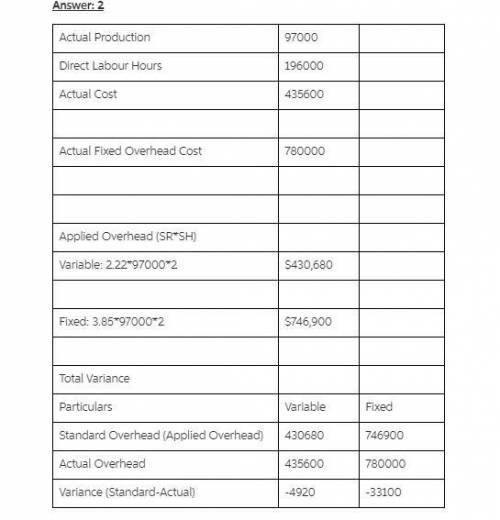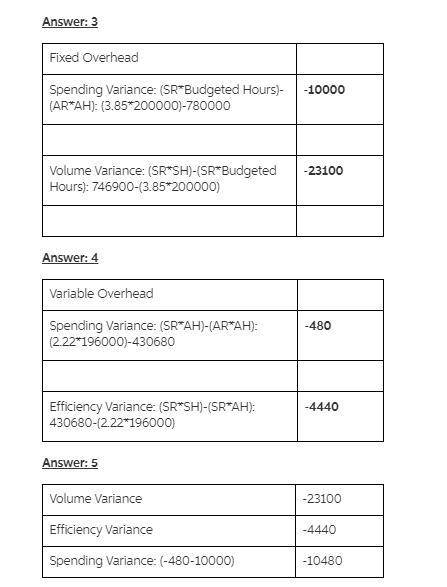
Overhead Application, Overhead Variances, Journal EntriesPlimpton Company produces countertop ovens. Plimpton uses a standard costing system. The standard costing system relies on direct labor hours to assign overhead costs to production. The direct labor standard indicates that two direct labor hours should be used for every oven produced. The normal production volume is 100,000 units. The budgeted overhead for the coming year is as follows:Fixed overhead $760,000Variable overhead 446,000**At normal volume. Plimpton applies overhead on the basis of direct labor hours. During the year, Plimpton produced 97,000 units, worked 196,000 direct labor hours, and incurred actual fixed overhead costs of $770,400 and actual variable overhead costs of $437,580.Required:1. Calculate the standard fixed overhead rate and the standard variable overhead rate. Round your answers to the nearest cent. Use rounded answers in the subsequent computations. Standard fixed overhead rate $ per direct labor hourStandard variable overhead rate $ per direct labor hour2. Compute the applied fixed overhead and the applied variable overhead. Use the application rates from part (1) in your calculations. Fixed $Variable $What is the total fixed overhead variance?$ UnfavorableWhat is the total variable overhead variance?$ Unfavorable3. Break down the total fixed overhead variance into a spending variance and a volume variance. Spending Variance $ UnfavorableVolume Variance $ Unfavorable4. Compute the variable overhead spending and efficiency variances. Spending Variance $ UnfavorableEfficiency Variance $ Unfavorable5. Now assume that Plimpton’s cost accounting system reveals only the total actual overhead. In this case, a three-variance analysis can be performed. Using the relationships between a three- and four-variance analysis, indicate the values for the three overhead variances. Volume variance $ UnfavorableVariable overhead efficiency variance $ UnfavorableSpending variance $ UnfavorableFeedback6. Prepare journal entries (1) to apply overhead to production, (2) to record the actual overhead costs incurred, (3) to record the variable and fixed overhead variances, and (4) to close the variance accounts at the end of the year. Assume variances are closed to Cost of Goods Sold. If an amount box does not require an entry, leave it blank or enter "0".

Answers: 2


Another question on Business

Business, 22.06.2019 10:40
Parks corporation is considering an investment proposal in which a working capital investment of $10,000 would be required. the investment would provide cash inflows of $2,000 per year for six years. the working capital would be released for use elsewhere when the project is completed. if the company's discount rate is 10%, the investment's net present value is closest to (ignore income taxes) ?
Answers: 1

Business, 22.06.2019 19:20
Advertisers are usually very conscious of their audience. choose an issue of a popular magazine such as time, sports illustrated, vanity fair, rolling stone, or the like. from that issue select three advertisements to analyze. try to determine the audience being appealed to in each advertisement and analyze the appeals used to persuade buyers. how might the appeals differ is the ads were designed to persuade a different audience.
Answers: 2

Business, 22.06.2019 21:10
Krier industries has just completed its sales forecasts and its marketing department estimates that the company will sell 43,800 units during the upcoming year. in the past, management has maintained inventories of finished goods at approximately 3 months' sales. however, the estimated inventory at the start of the year of the budget period is only 7,300 units. sales occur evenly throughout the year. what is the estimated production level (units) for the first month of the upcoming budget year?
Answers: 3

Business, 22.06.2019 22:10
Afirm plans to begin production of a new small appliance. the manager must decide whether to purchase the motors for the appliance from a vendor at $10 each or to produce them in-house. either of two processes could be used for in-house production; process a would have an annual fixed cost of $200,000 and a variable cost of $7 per unit, and process b would have an annual fixed cost of $175,000 and a variable cost of $8 per unit. determine the range of annual volume for which each of the alternatives would be best. (round your first answer to the nearest whole number. include the indifference value itself in this answer.)
Answers: 2
You know the right answer?
Overhead Application, Overhead Variances, Journal EntriesPlimpton Company produces countertop ovens....
Questions


Mathematics, 09.09.2021 07:00

Physics, 09.09.2021 07:00


Chemistry, 09.09.2021 07:00




Mathematics, 09.09.2021 07:00

Mathematics, 09.09.2021 07:10

Physics, 09.09.2021 07:10

Mathematics, 09.09.2021 07:10

Mathematics, 09.09.2021 07:10

Chemistry, 09.09.2021 07:10


History, 09.09.2021 07:10

Chemistry, 09.09.2021 07:10

Mathematics, 09.09.2021 07:10

Mathematics, 09.09.2021 07:10









